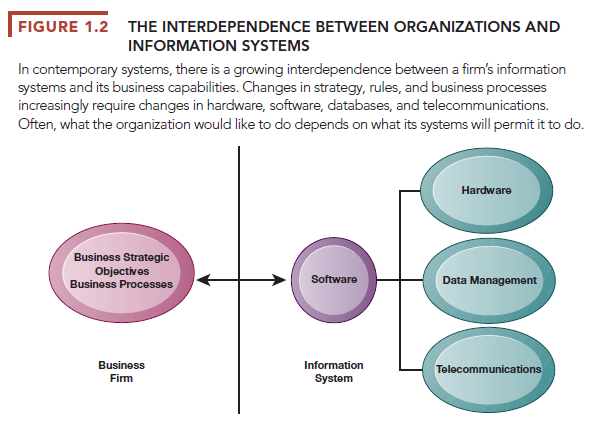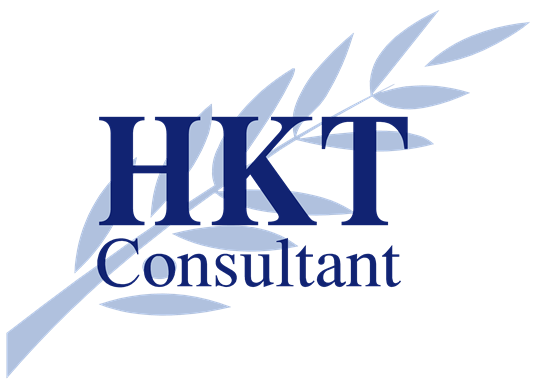What makes information systems so essential today? Why are businesses investing so much in information systems and technologies? In the United States, more than 25 million business and financial managers, and 36 million professional workers in the labor force rely on information systems to conduct business. Information systems are essential for conducting day-to-day business in the United States and most other advanced countries as well as achieving strategic business objectives.
Entire sectors of the economy are nearly inconceivable without substantial investments in information systems. E-commerce firms such as Amazon, eBay, Google, and E*Trade simply would not exist. Today’s service industries— finance, insurance, and real estate as well as personal services such as travel, medicine, and education—could not operate without information systems. Similarly, retail firms such as Walmart and Target and manufacturing firms such as General Motors and GE require information systems to survive and prosper. Just as offices, telephones, filing cabinets, and efficient tall buildings with elevators were once the foundations of business in the twentieth century, information technology is a foundation for business in the twenty-first century.
There is a growing interdependence between a firm’s ability to use information technology and its ability to implement corporate strategies and achieve corporate goals (see Figure 1.2). What a business would like to do in five years often depends on what its systems will be able to do. Increasing market share, becoming the high-quality or low-cost producer, developing new products, and increasing employee productivity depend more and more on the kinds and quality of information systems in the organization. The more you understand about this relationship, the more valuable you will be as a manager.
Specifically, business firms invest heavily in information systems to achieve six strategic business objectives: operational excellence; new products, services, and business models; customer and supplier intimacy; improved decision making; competitive advantage; and survival.

1. Operational Excellence
Businesses continuously seek to improve the efficiency of their operations in order to achieve higher profitability. Information systems and technologies are some of the most important tools available to managers for achieving higher levels of efficiency and productivity in business operations, especially when coupled with changes in business practices and management behavior.
Walmart, the largest retailer on earth, exemplifies the power of information systems coupled with state-of-the-art business practices and supportive management to achieve world-class operational efficiency. In fiscal year 2018, Walmart achieved over $500 billion in sales—nearly one-tenth of retail sales in the United States—in large part because of its Retail Link system, which digitally links its suppliers to every one of Walmart’s stores. As soon as a customer purchases an item, the supplier monitoring the item knows to ship a replacement to the shelf. Walmart is the most efficient retail store in the industry, achieving sales of more than $600 per square foot, compared with its closest competitor, Target, at $425 per square foot and other large general merchandise retail firms producing less than $200 per square foot.
2. New Products, Services, and Business Models
Information systems and technologies are a major enabling tool for firms to create new products and services as well as entirely new business models. A business model describes how a company produces, delivers, and sells a product or service to create wealth.
Today’s music industry is vastly different from the industry a decade ago. Apple Inc. transformed an old business model of music distribution based on vinyl records, tapes, and CDs into an online, legal distribution model based on its own iPod technology platform. Apple has prospered from a continuing stream of innovations, including the iTunes music service, the iPad, and the iPhone.
3. Customer and Supplier Intimacy
When a business really knows its customers and serves them well, the customers generally respond by returning and purchasing more. This raises revenues and profits. Likewise with suppliers, the more a business engages its suppliers, the better the suppliers can provide vital inputs. This lowers costs. How to really know your customers or suppliers is a central problem for businesses with millions of offline and online customers.
The Mandarin Oriental in Manhattan and other high-end hotels exemplify the use of information systems and technologies to achieve customer intimacy. These hotels use computers to keep track of guests’ preferences, such as their preferred room temperature, check-in time, frequently dialed telephone numbers, and television programs, and store these data in a large data repository. Individual rooms in the hotels are networked to a central network server computer so that they can be remotely monitored and controlled. When a customer arrives at one of these hotels, the system automatically changes the room conditions, such as dimming the lights, setting the room temperature, or selecting appropriate music, based on the customer’s digital profile. The hotels also analyze their customer data to identify their best customers and to develop individualized marketing campaigns based on customers’ preferences.
JCPenney exemplifies the benefits of information systems-enabled supplier intimacy. Every time a dress shirt is bought at a JCPenney store in the
United States, the record of the sale appears immediately on computers in Hong Kong at the TAL Apparel Ltd. supplier, a contract manufacturer that produces one in eight dress shirts sold in the United States. TAL runs the numbers through a computer model it developed and then decides how many replacement shirts to make and in what styles, colors, and sizes. TAL then sends the shirts to each JCPenney store, bypassing completely the retailer’s warehouses. In other words, JCPenney’s shirt inventory is near zero, as is the cost of storing it.
4. Improved Decision Making
Many business managers operate in an information fog bank, never really having the right information at the right time to make an informed decision. Instead, managers rely on forecasts, best guesses, and luck. The result is over- or underproduction of goods and services, misallocation of resources, and poor response times. These poor outcomes raise costs and lose customers. In the past decade, information systems and technologies have made it possible for managers to use real-time data from the marketplace when making decisions.
For instance, Verizon Corporation, one of the largest telecommunications companies in the United States, uses a web-based digital dashboard to provide managers with precise real-time information on customer complaints, network performance for each locality served, and line outages or storm-damaged lines. Using this information, managers can immediately allocate repair resources to affected areas, inform consumers of repair efforts, and restore service fast.
5. Competitive Advantage
When firms achieve one or more of these business objectives—operational excellence; new products, services, and business models; customer/supplier intimacy; and improved decision making—chances are they have already achieved a competitive advantage. Doing things better than your competitors, charging less for superior products, and responding to customers and suppliers in real time all add up to higher sales and higher profits that your competitors cannot match. Apple Inc., Walmart, and UPS, described later in this chapter, are industry leaders because they know how to use information systems for this purpose.
6. Survival
Business firms also invest in information systems and technologies because they are necessities of doing business. Sometimes these “necessities” are driven by industry-level changes. For instance, after Citibank introduced the first automated teller machines (ATMs) in the New York region in 1977 to attract customers through higher service levels, its competitors rushed to provide ATMs to their customers to keep up with Citibank. Today, virtually all banks in the United States have regional ATMs and link to national and international ATM networks, such as CIRRUS. Providing ATM services to retail banking customers is simply a requirement of being in and surviving in the retail banking business.
There are many federal and state statutes and regulations that create a legal duty for companies and their employees to retain records, including digital records. For instance, the Toxic Substances Control Act (1976), which regulates the exposure of U.S. workers to more than 75,000 toxic chemicals, requires firms to retain records on employee exposure for 30 years. The Sarbanes-Oxley Act (2002), which was intended to improve the accountability of public firms and their auditors, requires certified public accounting firms that audit public companies to retain audit working papers and records, including all e-mails, for five years. The Dodd-Frank Wall Street Reform and Consumer Protection Act (2010), which was intended to strengthen regulation of the banking industry, requires firms to retain all records for 10 years. Many other pieces of federal and state legislation in health care, financial services, education, and privacy protection impose significant information retention and reporting requirements on U.S. businesses. Firms turn to information systems and technologies to provide the capability to respond to these challenges.
Source: Laudon Kenneth C., Laudon Jane Price (2020), Management Information Systems: Managing the Digital Firm, Pearson; 16th edition.

I was recommended this blog by my cousin. I’m not sure whether this post is written by him as nobody else know such detailed about my trouble. You’re wonderful! Thanks!
Please provide me with more details on the topic
Thanks for your help and for posting this. It’s been wonderful.
Thanks for posting. I really enjoyed reading it, especially because it addressed my problem. It helped me a lot and I hope it will help others too.